
Unlocking the Magic of Symmetry: The Power of Palindromes Worksheets in Education
In the vast and fascinating world of language and numbers, certain curiosities stand out, captivating our minds with their inherent elegance and symmetry. Among these, palindromes hold a special place. A palindrome, derived from the Greek words "palin" (back again) and "dromos" (way), is a word, number, phrase, or other sequence of characters which reads the same backward as forward. From simple words like "level" and "madam" to complex sentences like "A man, a plan, a canal: Panama!", palindromes offer a unique blend of linguistic playfulness and mathematical precision.
Beyond their recreational appeal, palindromes serve as powerful educational tools. They can be instrumental in developing a wide range of cognitive skills, from literacy and numeracy to critical thinking and pattern recognition. And when it comes to structured learning and reinforcement, few resources are as effective and versatile as Palindromes worksheets. These carefully designed educational materials provide a hands-on, engaging, and systematic approach to exploring the world of symmetry in words and numbers, making abstract concepts tangible and fun for learners of all ages.
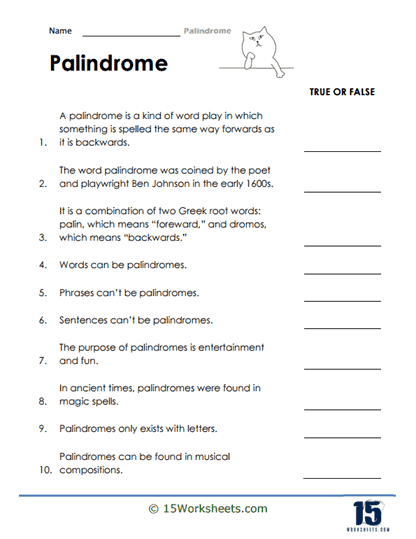
What Exactly Are Palindromes? A Deeper Dive
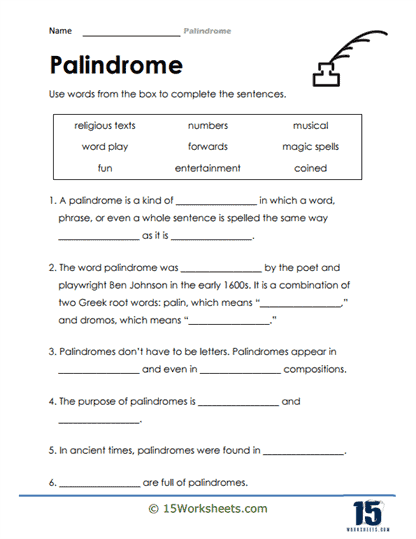
Before delving into the specifics of educational worksheets, it’s crucial to fully grasp the nature of palindromes. They are not merely linguistic quirks but manifestations of symmetry that appear across various domains:
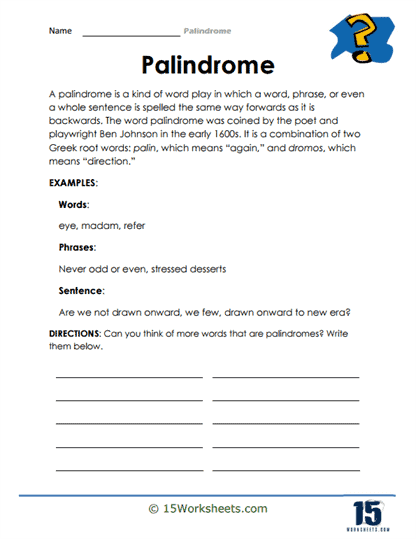
- Word Palindromes: These are the most common and often the first type introduced. Examples include "rotor," "kayak," "racecar," "refer," and "deified." They are perfect for initial identification exercises.
- Number Palindromes: Numbers that read the same forwards and backward, such as 121, 55, 787, or 12321. These are excellent for introducing mathematical symmetry and properties.
- Phrase Palindromes: More complex and often humorous, these include phrases like "No lemon, no melon," "Was it a car or a cat I saw?", or "Madam, I’m Adam." Punctuation and spacing are often ignored, focusing on the sequence of letters.
- Sentence Palindromes: The pinnacle of palindrome creation, these are full sentences that maintain their meaning and form when reversed. "A man, a plan, a canal: Panama!" is perhaps the most famous example, attributed to the construction of the Panama Canal.
- Date Palindromes: Specific dates that read the same forwards and backward, like 02/02/2020 or 11/02/2011 (depending on date format). These often capture public imagination.
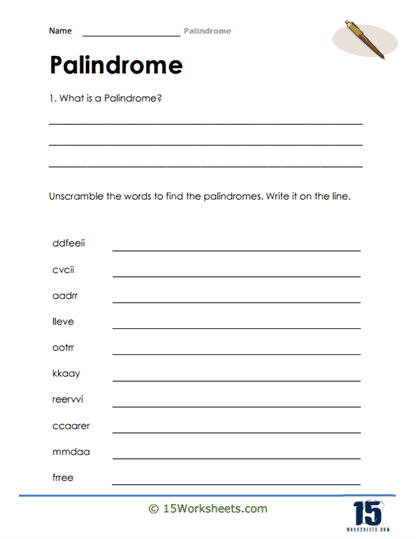
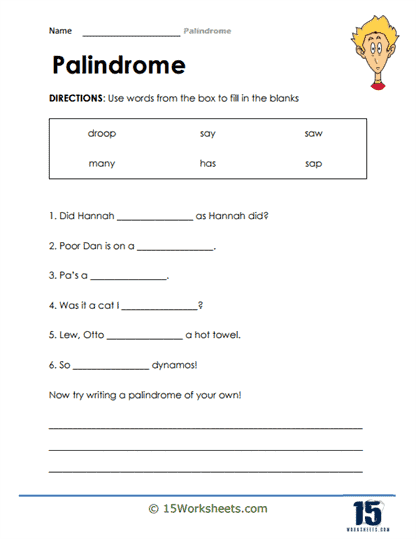
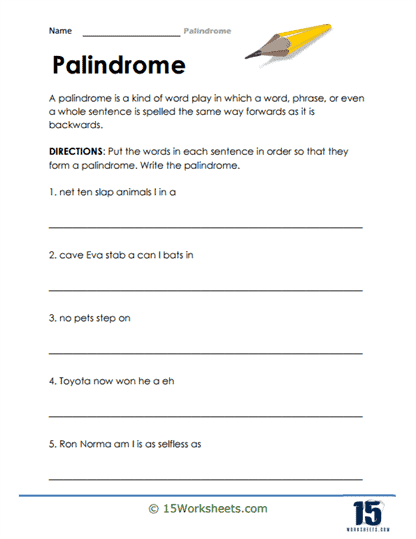
The beauty of palindromes lies in their inherent pattern. Recognizing this pattern is the first step towards understanding their educational value.
Why Teach Palindromes? Educational Benefits Beyond the Fun

While the playful nature of palindromes makes them inherently engaging, their educational benefits run deep, impacting various aspects of a learner’s development:
-
Literacy Enhancement:
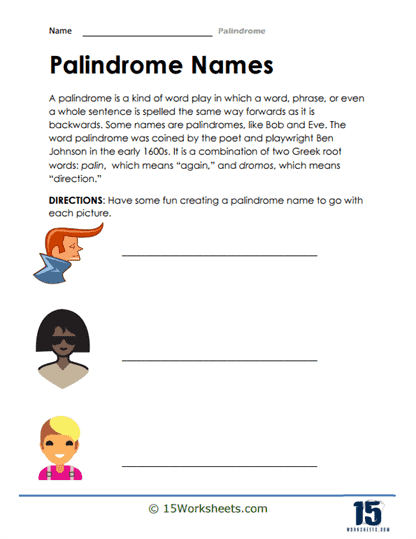
- Spelling and Vocabulary: Identifying and creating word palindromes reinforces spelling patterns and expands vocabulary. Learners pay closer attention to letter sequences.
- Reading Comprehension: Analyzing longer phrase and sentence palindromes requires careful reading and understanding of how words fit together.
- Phonological Awareness: Recognizing how sounds align when words are reversed can improve auditory processing and phonics skills.
- Word Structure: Understanding prefixes, suffixes, and root words can be subtly reinforced when manipulating words to form palindromes.
-
Numeracy Skills Development:
- Number Sense: Exploring number palindromes helps children understand number properties and place value.
- Arithmetic Operations: The concept of reversing numbers often leads to interesting mathematical problems, such as the "196 algorithm" where you repeatedly add a number to its reverse until a palindrome is formed (e.g., 19 + 91 = 110; 110 + 011 = 121). This introduces addition and number patterns in a unique way.
- Symmetry in Math: Palindromes provide a concrete example of mathematical symmetry, connecting language arts to mathematical concepts.
-
Cognitive and Critical Thinking:
- Pattern Recognition: The core of palindrome identification is recognizing a specific pattern. This skill is transferable to all academic subjects and real-world problem-solving.
- Logical Reasoning: Determining if a sequence is a palindrome requires logical deduction and systematic checking.
- Problem-Solving: Creating new palindromes, especially longer ones, is a creative problem-solving task that encourages experimentation and perseverance.
- Attention to Detail: The slightest misplacement of a letter or number breaks the palindrome, fostering meticulousness.
-
Creativity and Language Play:
- Palindromes encourage a playful approach to language, inspiring learners to experiment with words and think outside the box. This can spark an interest in creative writing and poetry.
-
Cross-Curricular Connections:
- Palindromes can be integrated into history (e.g., famous palindrome dates), art (symmetry in design), and even computer science (string manipulation, algorithms).
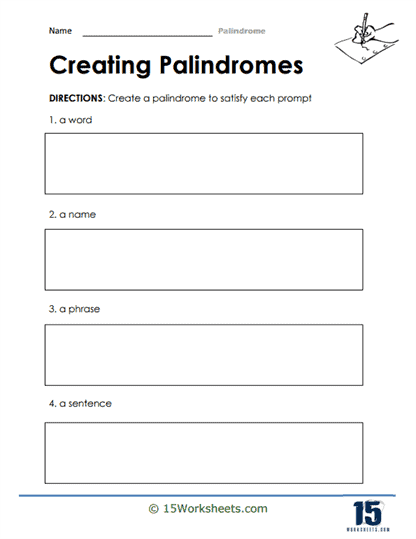
The Role of Palindromes Worksheets in Learning
Given the extensive benefits, how do educators and parents effectively introduce and reinforce the concept of palindromes? This is where Palindromes worksheets become an indispensable resource. They offer a structured, progressive, and engaging platform for learners to practice, apply, and master their understanding of these symmetrical wonders.
Types of Palindromes Worksheets:
-
Identification Worksheets:
- "Circle the Palindrome": Learners are given a list of words or numbers and asked to identify which ones are palindromes. This is ideal for beginners.
- "True or False": Statements like "Racecar is a palindrome" require a simple yes/no answer.
- "Color the Palindrome": A visually engaging activity where correct palindromes are colored in.
-
Creation Worksheets:
- "Make Your Own Word Palindrome": Provide a starting letter or a theme, and students create their own.
- "Complete the Palindrome": Give half a word (e.g., "lev…") and students complete it ("…el").
- "Number Palindrome Challenge": Students are given a starting number and challenged to find the next smallest or largest number palindrome.
-
Reversal and Transformation Worksheets:
- "Reverse These Words/Numbers": Simple exercises where learners practice writing sequences backward.
- "The Palindrome Sum": Introduce the number reversal algorithm (e.g., add a number to its reverse until a palindrome is formed). This combines arithmetic with palindrome recognition.
- "Phrase Reversal": Learners are given a phrase and asked to reverse it, then check if it forms a palindrome.
-
Sentence and Phrase Palindrome Worksheets:
- "Decode the Palindrome": Provide scrambled letters or missing words for a famous palindrome phrase, and students reconstruct it.
- "Create a Palindrome Sentence": A more advanced challenge where students try to construct their own meaningful sentence palindromes.
-
Themed and Cross-Curricular Worksheets:
- "Palindromes Word Search/Crossword": Puzzles where all the answers are palindromes.
- "Date Palindrome Calendar": Students identify or search for palindromic dates within a given year or month.
Benefits of Using Palindromes Worksheets:
- Structured Practice: Worksheets provide a systematic way to practice concepts, moving from simple identification to complex creation.
- Reinforcement: Repeated exposure and practice solidify understanding and retention.
- Assessment: Educators can quickly gauge a student’s comprehension and identify areas needing further attention.
- Independent Learning: Worksheets allow students to work at their own pace, fostering self-reliance and focus.
- Differentiation: Worksheets can be easily adapted to various learning levels, providing simpler tasks for beginners and more challenging ones for advanced learners.
- Convenience: They are easy to prepare, print, and distribute, making them a go-to resource for both classroom teachers and homeschooling parents.
- Quiet Activity: Worksheets offer a focused, quiet activity that can be used for individual work, homework, or as part of a learning center.
Well-designed Palindromes worksheets can transform abstract concepts into engaging, hands-on activities that cater to diverse learning styles. They provide the necessary scaffold for learners to build confidence and proficiency in recognizing, creating, and appreciating the elegance of palindromes.
Designing and Implementing Effective Palindromes Worksheets
To maximize the impact of Palindromes worksheets, consider these best practices:
- Age-Appropriateness: Tailor the complexity of the palindromes and the tasks to the age and developmental stage of the learners. Young children might start with 3-letter word palindromes, while older students can tackle long phrases or number reversal algorithms.
- Clear Instructions: Ensure instructions are concise, unambiguous, and easy for students to follow independently.
- Variety: Mix different types of activities within a set of worksheets to keep engagement high. Don’t just stick to identification; include creation, problem-solving, and critical thinking tasks.
- Visual Appeal: Use clear fonts, appropriate spacing, and perhaps some relevant illustrations or graphics to make the worksheets inviting and easy on the eyes.
- Integration: Connect palindromes to other subjects. For example, use numbers from a math lesson, or words from a current vocabulary list.
- Beyond the Worksheet: While worksheets are excellent for practice, combine them with interactive activities, discussions, and real-world examples to provide a holistic learning experience. Encourage students to find palindromes in books, street signs, or even their own names (if possible!).
- Feedback and Discussion: Don’t just grade and return. Go over the answers, discuss common mistakes, and celebrate successful palindrome creations. This reinforces learning and builds confidence.
Beyond the Worksheet: Extending the Learning
While Palindromes worksheets are invaluable, the learning doesn’t have to stop there. Encourage students to:
- Play Palindrome Games: Online quizzes, interactive apps, or classroom games like "Palindrome Pictionary."
- Creative Writing: Challenge them to write short stories or poems that incorporate palindromes.
- Scavenger Hunts: Look for palindromes in everyday life.
- Research: Explore the history of famous palindromes or the mathematical properties of number palindromes.
Conclusion
Palindromes, with their enchanting symmetry and intriguing structure, offer a unique gateway to fostering essential literacy, numeracy, and cognitive skills. They transform potentially dry concepts into engaging puzzles that spark curiosity and encourage analytical thinking. Among the various tools available to educators and parents, Palindromes worksheets stand out as a highly effective and versatile resource. They provide the structured practice, clear reinforcement, and assessment opportunities necessary to truly unlock the magic of these symmetrical wonders. By integrating these worksheets into a broader educational strategy, we can empower learners to not only recognize and create palindromes but also to appreciate the inherent beauty and order found within language and numbers, paving the way for a deeper understanding of the world around them.
